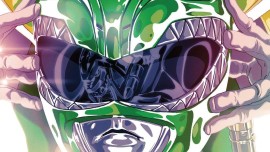Everyone keeps secrets. Big or small, some say that we protect ourselves by hiding our problems from friends and loved ones. We tell ourselves that nobody would want to help with our problems, because we should be able to bear the weight of our secrets by ourselves. You might be wondering what this exactly has to do with a series not known for dealing with this type or typical human behavior. While the seeds for this critical moment were sowed in the past three issues, Kyle Higgins shows us that even Power Rangers can still be human.
Before diving off into the psychosis of Tommy Oliver, I want to acknowledge something that only viewers of MMPR could possibly pick up on. If you remember, Jason, Trini, and Zach all left the team to be part of a UN mission. With the exception of Jason (who still commands the leader role extremely well), I felt that Higgins began to set the stage for at least Trini and Zach to leave the team at some juncture. It’s more believable in Zach’s case due to his mistrust of Tommy, which could lead to a falling out in which Zach doesn’t want to be a part of a team with a potential hazard like Tommy. Trini has a great character moment, as both Tommy and the readers have a greater understanding of her character within this universe. It could all be a red herring and no Ranger leaves, but I couldn’t help but recall the famous Ranger departure.
The crux of this issue boils down to Tommy Oliver dealing with PTSD. The signs are all there: the hallucinations, the aggression and ultimately the hiding. Some might argue that this doesn’t mesh with a property like Power Rangers, a show now turned comic dedicated to fighting the bad guy of the week. Higgins uses the format of serialized storytelling to tell a deeper narrative than the original show ever could. Veteran fans should be able to appreciate a more mature narrative that has weight and consequence, and one that doesn’t lean towards immaturity. The best stories are ones where it can make a reader think about the situation that their characters are in. Props to Higgins for writing this type of story.
Despite the emotional roller coaster, this is still a Power Rangers comic so of course we get some Zord on Zord action. After four issues, I’ve come to the conclusion that Hendrys Prasetya’s art is at it’s best when the Rangers are on the page or when the Zords come to life. His storytelling remains consistent and his facial expressions continue to get better with each issue. On a closing note, I did enjoy how Prasetya framed the final panel with the Dragon Zord underneath a cruise ship like a shark stalking it’s prey; it was well done and left me excited for the next issue.
It’s issues like this one that make me enjoy the backup story even more. Steve Orlando understands the absolute silliness that comes with Bulk and Skull, and while it’s slightly exaggerated it’s purpose as a palate cleanser to the main story.
Mighty Morphin Power Rangers #3 earns a 4/5
